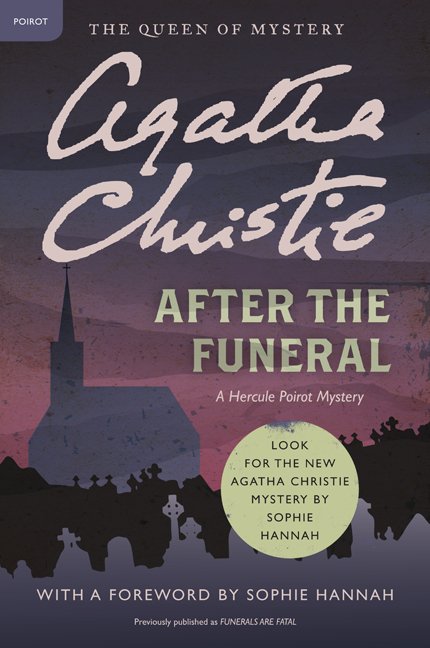Alright, we are wrapping up the Summer of Christie and Sophie Hannah’s new Poirot mystery The Monogram Murders is just around the corner. I’d like to thank Book Club Girl for hosting our discussions and to Kaitlin at William Morrow for sending us books and asking great questions.
1.) From the beginning, there is tension among the surviving Abernethie family. Despite being bound together by name and blood, there doesn’t seem to be a strong connection amongst the different generations. Did you sense a motive for murder or suspect someone in the group early on?
There is something about inter-familial feuding that is incredibly awkward for the outsider. Although I suppose it’s none too comfortable for the family members either, it’s a bit like watching a pack of hyenas fight over a carcass at the zoo. Here we have three outsiders – Mr. Entwhistle, Poirot (under a pseudonym) and the reader – who are all affected by the behavior on display. However, if I were reading this (without knowing typical Agatha Christie) I might not have suspected murder was on the horizon. Dysfunction, yes.
2.) It was noted early on that Helen Abernethie felt something was strange during the will reading. Were you ever able to guess what it was she sensed? Once the murder plot is revealed, it becomes clear that the answer was there from the beginning.
I think it was clear that the identity of someone was being faked. The idea that none had been together for several years made that a probable outcome. As to who and why, I don’t think that was discoverable by anyone except Poirot.
3.) Name some of your favorite red herrings, as there are quite a few. To get you going, I enjoyed the reoccurrence of nuns. I knew they had to have some significance, as nothing can just be a coincidence.
Firstly, I’m not sure that the nuns *were* a red herring. I mean, their incessant appearance helped Poirot to understand the unrelated nature of the deaths. Oh, and I was sure the waxflowers were important but like Helen, I couldn’t quite figure out why.
4.) The will was split fairly across Richard’s relatives and each had their own reason for needing the money. Did you ever once consider Cora’s murder to be separate from Richard’s?
Not for any reason other than it is an Agatha Christie novel. Although I did think Miss Gilchrist knew more than she was letting on.
5.) Some of the family members (by blood or marriage) acted truly deplorably—there was the house-bound Timothy, the beautiful but vapid Rosamund and her cheating husband Michael, and Susan’s husband, Gregory who was outed as a mental patient. I half expected Helen to have her own dirty secret (which really wasn’t all that bad once revealed). Did you consider any of them for the murderer?
Truthfully they all seemed to want to complain and eviscerate one another. It seemed doubtful any one of them would take the time to create a real plan and execute it.
6.) In Sophie Hannah’s introduction to After the Funeral, she discusses the Christie-concept of “nontransferable motive,” meaning a motive that no other murderer in any other crime novel has had or will have. Do you think that applies to After the Funeral? What do you make of a “nontransferable motive?” Does this apply to other Christie mysteries?
I think this ties into the idea of the suspension of disbelief as well. How far is the reader willing to allow the writer to go, for the sake of a good yarn? If you mean that no one else will mistakenly kill over a painting while using a poisoned slice of cake with nuns as a cover, then yes, that is pretty nontransferable. But if it’s just murder due to greed, tied up in a piece of art, then I’m sure it’s been done.
7.) This was my first time reading After the Funeral, and I couldn’t help but think this had all the components of a classic Christie mystery. What are some of those elements?
A glorious cast of characters, brought together by unwelcome circumstances to a once-brilliant family estate, to begin with. There is also the reveal, once everyone has gathered to view the unmasking. I think it is somewhat unusual as well – Poirot doesn’t show up until halfway through the story. Much of the early fact-gathering is done by Mr. Entwhistle, who is sort of deputized by the plucky Belgian. Indeed, Poirot’s hiring the private investigator is irregular. Lastly, perhaps even unconsciously, Christie injects her stories with topics of the day. Estate tax and death duties were still weighing heavily on the country’s pocketbooks. Coming into some money, particularly through selling a painting would be the equivalent of winning the tax-free lottery. Christie manages to wrap all this in a neat puzzle with a bow.
Please be sure to read other readers’ comments here. And watch Sophie Hannah talk about After the Funeral here.

